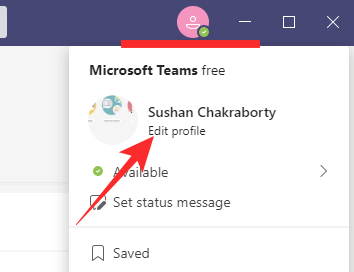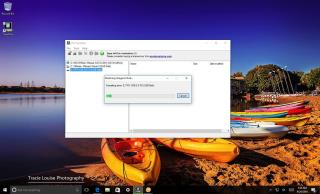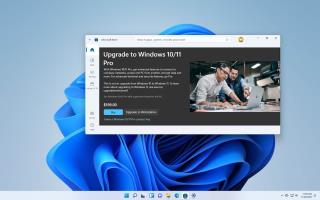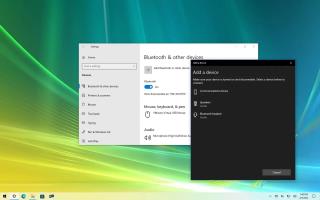วิธีลบรูปภาพของคุณจาก Microsoft Teams บนมือถือหรือคอมพิวเตอร์

เรียนรู้วิธีลบรูปโปรไฟล์จาก Microsoft Teams สำหรับทั้งมือถือและคอมพิวเตอร์ ด้วยขั้นตอนง่ายๆ ที่จะช่วยเพิ่มความเป็นส่วนตัวของคุณ

ระบบปฏิบัติการคือหัวใจสำคัญของพีซีทุกเครื่อง เพราะหากไม่มีระบบเหล่านี้ จะไม่สามารถส่งอีเมล ดูวิดีโอเกี่ยวกับแมว หรือแชทกับเพื่อนของเราได้ แต่ในบางครั้ง ทุกระบบปฏิบัติการก็พบปัญหาต่างๆ เช่น การบูทเครื่องช้า แอพขัดข้อง การแสดงผิดพลาด เสียงว่องไว และอีกมากมาย
หากคุณรู้สึกว่า Windows 11 ของคุณมีพฤติกรรมผิดปกติเมื่อเร็ว ๆ นี้ เราคิดว่าถึงเวลาที่จะต้องจัดการเรื่องนี้เองและซ่อมแซม Windows 11
ก่อนที่คุณจะรีบเร่งไปที่เทคโนโลยีการซ่อมพีซีที่ใกล้ที่สุด มาดูวิธีการต่าง ๆ ที่มีอยู่เพื่อช่วยคุณซ่อมแซมการติดตั้ง Windows 11 ที่เสียหาย
สารบัญ
วิธีที่ #1: ใช้ตัวแก้ไขปัญหาของ Windows
เครื่องมือแก้ปัญหาของ Windows มาไกลมาก และตอนนี้พวกเขาสามารถแก้ไขปัญหาส่วนใหญ่ของคุณได้ด้วยการคลิกง่ายๆ คำสั่งและการตรวจสอบการแก้ไขปัญหาส่วนใหญ่ที่ดำเนินการตามปกติผ่าน CMD และ PowerShell จะรวมอยู่ในเครื่องมือแก้ไขปัญหาแล้ว ซึ่งทำให้ใช้งานได้มากขึ้นเมื่อพบปัญหา หากคุณยังไม่สามารถแก้ไขและซ่อมแซมการติดตั้ง Windows 11 ของคุณได้ ตัวแก้ไขปัญหาอาจคุ้มค่าที่จะลอง ใช้คำแนะนำด้านล่างเพื่อเริ่มต้น
กดWindows + iบนแป้นพิมพ์เพื่อเปิดแอปการตั้งค่า ตรวจสอบให้แน่ใจว่าได้เลือก 'ระบบ' ทางด้านซ้ายของคุณ จากนั้นคลิกที่ 'แก้ไขปัญหา' ทางด้านขวาของคุณ
![วิธีซ่อมแซม Windows 11 [15 วิธี] วิธีซ่อมแซม Windows 11 [15 วิธี]](/resources8/images31/image-6439-0105182722076.png)
คลิกที่ 'ตัวแก้ไขปัญหาอื่นๆ'
![วิธีซ่อมแซม Windows 11 [15 วิธี] วิธีซ่อมแซม Windows 11 [15 วิธี]](/resources8/images31/image-405-0105182722143.png)
ค้นหาตัวแก้ไขปัญหาที่เกี่ยวข้องสำหรับปัญหาปัจจุบันของคุณ ขึ้นอยู่กับปัญหาที่คุณมีกับการติดตั้ง คลิกที่ 'เรียกใช้' ข้างตัวแก้ไขปัญหา
![วิธีซ่อมแซม Windows 11 [15 วิธี] วิธีซ่อมแซม Windows 11 [15 วิธี]](/resources8/images31/image-9440-0105182722204.png)
ตอนนี้ตัวแก้ไขปัญหาจะทำสิ่งนั้นและแก้ไขปัญหาที่พบในส่วนประกอบหรือคุณสมบัติที่เกี่ยวข้อง
![วิธีซ่อมแซม Windows 11 [15 วิธี] วิธีซ่อมแซม Windows 11 [15 วิธี]](/resources8/images31/image-9235-0105182955896.png)
วิธีที่ #2: ถอนการติดตั้งและติดตั้งการอัปเดต Windows ล่าสุดทั้งหมดอีกครั้ง
หากคุณกำลังเผชิญกับข้อขัดข้องแบบสุ่ม ประสิทธิภาพการทำงานช้า กระตุก หรือจุดบกพร่องหลังจากอัปเดต Windows ล่าสุด คุณสามารถลองถอนการติดตั้งการอัปเดตล่าสุดเพื่อแก้ปัญหาของคุณได้ การอัปเดตเหล่านี้ควรเปลี่ยนกลับด้วยการคืนค่าระบบโดยใช้คำแนะนำที่ด้านบน แต่ในกรณีที่คุณไม่มีจุดคืนค่า คุณสามารถใช้คำแนะนำด้านล่างเพื่อถอนการติดตั้ง Windows Updates ด้วยตนเองจากระบบ Windows 11 ของคุณ
กดWindows + iบนแป้นพิมพ์เพื่อเปิดแอปการตั้งค่า ตอนนี้คลิกที่ Windows Update ทางด้านซ้ายของคุณ
![วิธีซ่อมแซม Windows 11 [15 วิธี] วิธีซ่อมแซม Windows 11 [15 วิธี]](/resources8/images31/image-6752-0105182955965.png)
คลิกที่ 'อัปเดตประวัติ'
![วิธีซ่อมแซม Windows 11 [15 วิธี] วิธีซ่อมแซม Windows 11 [15 วิธี]](/resources8/images31/image-9408-0105182722517.png)
เลื่อนไปที่ด้านล่างแล้วคลิก 'ถอนการติดตั้งการอัปเดต'
![วิธีซ่อมแซม Windows 11 [15 วิธี] วิธีซ่อมแซม Windows 11 [15 วิธี]](/resources8/images31/image-1959-0105182722745.png)
ตอนนี้คุณจะถูกนำไปที่แผงควบคุมซึ่งคุณจะได้รับรายการอัปเดตหลักล่าสุดทั้งหมดที่ติดตั้งในระบบของคุณ คุณจะไม่ได้รับการอัปเดตด้านความปลอดภัยในรายการนี้ เนื่องจากไม่สามารถถอนการติดตั้งได้ด้วยเหตุผลด้านความปลอดภัย คลิกและเลือกการอัปเดตที่คุณต้องการถอนการติดตั้ง
![วิธีซ่อมแซม Windows 11 [15 วิธี] วิธีซ่อมแซม Windows 11 [15 วิธี]](/resources8/images31/image-3028-0105182722836.png)
ตอนนี้คลิกที่ 'ถอนการติดตั้ง' ที่ด้านบน
![วิธีซ่อมแซม Windows 11 [15 วิธี] วิธีซ่อมแซม Windows 11 [15 วิธี]](/resources8/images31/image-2165-0105182722899.png)
หมายเหตุ:หากคุณไม่ได้รับตัวเลือกถอนการติดตั้ง อาจเป็นเพราะคุณกำลังพยายามถอนการติดตั้งส่วนประกอบ Windows ที่สำคัญซึ่งจะทำลายฟังก์ชันการทำงานของการติดตั้งปัจจุบันของคุณ
คลิกที่ 'ใช่' เพื่อยืนยันการเลือกของคุณ
![วิธีซ่อมแซม Windows 11 [15 วิธี] วิธีซ่อมแซม Windows 11 [15 วิธี]](/resources8/images31/image-9581-0105182722985.png)
การอัปเดตที่เลือกจะถูกถอนการติดตั้งจากระบบของคุณ เราขอแนะนำให้คุณรีสตาร์ทระบบและตรวจสอบว่าปัญหาที่คุณกำลังเผชิญได้รับการแก้ไขแล้วหรือไม่ หากไม่เป็นเช่นนั้น ให้ถอนการติดตั้ง Windows Updates ต่อไปจนกว่าคุณจะพบผู้กระทำความผิด
วิธีที่ #3: การกู้คืนไปยังจุดคืนค่าระบบที่เก่ากว่า
หมายเหตุ:วิธีนี้ถือว่าคุณมี Windows 11 ที่ใช้งานได้ซึ่งคุณสามารถบูตได้
คุณสามารถคิดว่า System Restore Points เป็นแนวทางในการกู้คืนระบบของคุณเป็น Windows เวอร์ชันก่อนหน้า (เมื่อมีการสร้างจุดคืนค่า) ควบคู่ไปกับแอปและการตั้งค่าต่างๆ ที่พีซีของคุณมีในตอนนั้น
Windows 11 จะสร้างจุดคืนค่าระบบโดยอัตโนมัติตามช่วงเวลาปกติ หากต้องการ คุณสามารถสร้างจุดคืนค่าได้
นอกจากนี้ยังสร้างขึ้นเมื่อมีการติดตั้งแอปพลิเคชันใหม่หรือการอัปเดต Windows
ต่อไปนี้คือวิธีที่คุณสามารถลองซ่อมแซม Windows 11 โดยใช้จุดคืนค่า
เปิดเมนู "เริ่ม" และพิมพ์ "สร้างจุดคืนค่า" จากนั้นคลิกที่ตัวเลือกที่แสดงด้านล่าง
![วิธีซ่อมแซม Windows 11 [15 วิธี] วิธีซ่อมแซม Windows 11 [15 วิธี]](/resources8/images31/image-7098-0105182723056.png)
เมนูป๊อปอัปควรเปิดขึ้นพร้อมกับชื่อ 'คุณสมบัติของระบบ' และคุณควรจะเห็นตัวเลือกที่เกี่ยวข้องกับการคืนค่าระบบดังที่แสดงด้านล่าง
![วิธีซ่อมแซม Windows 11 [15 วิธี] วิธีซ่อมแซม Windows 11 [15 วิธี]](/resources8/images31/image-1063-0105182723121.png)
หากเมนูป๊อปอัปของคุณดูเหมือนกับของเราโดยปิด 'การป้องกัน' สำหรับไดรฟ์ทั้งหมดของคุณ เราก็มีข่าวร้ายสำหรับคุณ เนื่องจากไม่มีจุดคืนค่าระบบก่อนหน้านี้ จึงไม่มีประโยชน์ที่จะดำเนินการต่อไปด้วยวิธีนี้ เนื่องจากไม่มีจุดคืนค่าที่จะย้อนกลับ
ณ จุดนี้ เราขอแนะนำให้ลองใช้วิธีถัดไป
เคล็ดลับ:หากคุณกำลังอ่านข้อความนี้เพียงเพื่อดูว่าสิ่งต่าง ๆ ทำงานอย่างไร เราขอแนะนำให้คุณเปิดการป้องกันสำหรับไดรฟ์ระบบของคุณ (เน้นที่ด้านล่าง) ไดรฟ์ที่มี Windows 11 และสร้างจุดคืนค่าทันที
![วิธีซ่อมแซม Windows 11 [15 วิธี] วิธีซ่อมแซม Windows 11 [15 วิธี]](/resources8/images31/image-2132-0105182723214.png)
นี่คือวิธีที่คุณสามารถทำได้
เลือกไดรฟ์ที่ระบุว่า 'ระบบ' และคลิกที่ 'กำหนดค่า'
![วิธีซ่อมแซม Windows 11 [15 วิธี] วิธีซ่อมแซม Windows 11 [15 วิธี]](/resources8/images31/image-6753-0105182723323.png)
จากนั้นคลิกที่ปุ่ม 'เปิดการป้องกันระบบ' และจัดสรรพื้นที่บางส่วนสำหรับจุดคืนค่าระบบโดยเลื่อนแถบเลื่อนด้านล่าง เราได้จัดสรรไดรฟ์ระบบของเราเพียง 4% ซึ่งใกล้เคียงกับ 4.5GB
หากจุดคืนค่าเพิ่มขึ้นในจำนวนหรือขนาด จุดเก่าจะถูกลบออกโดยอัตโนมัติเพื่อให้มีที่ว่างสำหรับจุดใหม่
คลิกที่ 'สมัคร' จากนั้น 'ตกลง'
![วิธีซ่อมแซม Windows 11 [15 วิธี] วิธีซ่อมแซม Windows 11 [15 วิธี]](/resources8/images31/image-2650-0105182723417.png)
ไดรฟ์ที่คุณเลือกไว้ก่อนหน้านี้ควรเปิด 'การป้องกัน' และตอนนี้คุณควรจะสามารถสร้างจุดคืนค่าระบบได้
![วิธีซ่อมแซม Windows 11 [15 วิธี] วิธีซ่อมแซม Windows 11 [15 วิธี]](/resources8/images31/image-3719-0105182723520.png)
ขณะที่คุณอยู่ในเมนูป๊อปอัปเดียวกัน ให้คลิกที่ปุ่ม 'สร้าง' เพื่อสร้าง System Restore Point เป็นครั้งแรกในพีซีของคุณ
![วิธีซ่อมแซม Windows 11 [15 วิธี] วิธีซ่อมแซม Windows 11 [15 วิธี]](/resources8/images31/image-7789-0105182723725.png)
ตอนนี้ควรมีป๊อปอัปถามชื่อจุดคืนค่าของคุณ อย่าลังเลที่จะพิมพ์สิ่งที่คุณต้องการ เพื่อความสะดวกของคุณ เวลาและข้อมูลระบบปัจจุบันของพีซีของคุณจะถูกเพิ่มโดยอัตโนมัติเพื่อให้จุดคืนค่านี้แตกต่างจากที่อื่น สำหรับตอนนี้ เรากำลังพิมพ์ "Fresh Install" เนื่องจากเราเพิ่งติดตั้ง Windows 11 ใหม่อีกครั้ง
เมื่อเสร็จแล้วให้คลิกที่ 'สร้าง'
![วิธีซ่อมแซม Windows 11 [15 วิธี] วิธีซ่อมแซม Windows 11 [15 วิธี]](/resources8/images31/image-2823-0105182723892.png)
หลังจากนั้นไม่นาน จุดคืนค่าของคุณควรพร้อม ตอนนี้คุณควรจะตรวจสอบได้โดยคลิกที่ปุ่ม 'System Restore'
![วิธีซ่อมแซม Windows 11 [15 วิธี] วิธีซ่อมแซม Windows 11 [15 วิธี]](/resources8/images31/image-7821-0105182956057.png)
คลิกที่ ต่อไป.
![วิธีซ่อมแซม Windows 11 [15 วิธี] วิธีซ่อมแซม Windows 11 [15 วิธี]](/resources8/images31/image-7756-0105182724049.png)
และจุดคืนค่าระบบที่สร้างขึ้นใหม่ของคุณควรอยู่ที่นี่
![วิธีซ่อมแซม Windows 11 [15 วิธี] วิธีซ่อมแซม Windows 11 [15 วิธี]](/resources8/images31/image-6893-0105182724113.png)
การเลือกจุดคืนค่าและคลิกปุ่ม "ถัดไป" (เปิดใช้งานแล้ว) จะนำคุณไปสู่การคืนค่าพีซีของคุณจนถึงช่วงเวลาที่สร้างจุดคืนค่า
วิธีที่ #4: การใช้เครื่องมือพรอมต์คำสั่ง SFC
System File Checker (SFC) และ Deployment Image Servicing and Management (DISM) เป็นเครื่องมือบรรทัดคำสั่งสองเครื่องมือที่มักใช้โดยเทคโนโลยีไอทีในองค์กรเพื่อให้บริการเครื่อง Windows
หากนี่เป็นครั้งแรกที่คุณเคยได้ยินเกี่ยวกับเครื่องมือเหล่านี้ ก็ไม่มีอะไรต้องกังวล เพราะโดยทั่วไปถือว่าเป็นเครื่องมือไฟฟ้าและไม่ค่อยมีคนรู้จักเกี่ยวกับเครื่องมือเหล่านี้
มาเริ่มกันที่ SFC ก่อนแล้วดูว่าคุณสามารถซ่อมแซม Windows 11 ได้อย่างไร
สามารถใช้ SFC เพื่อสแกนและตรวจสอบไฟล์ที่ได้รับการป้องกัน (ไฟล์ Windows) หากพบว่าไฟล์เสียหายและไม่สามารถตรวจสอบได้ จะพยายามกู้คืนสำเนาใหม่จากโฟลเดอร์ด้านล่างในพีซีของคุณ
C:\Windows
นี่คือวิธีที่คุณสามารถลองใช้ตัวเลือกนี้ได้
คลิกปุ่ม 'เริ่ม' พิมพ์ "พรอมต์คำสั่ง" และตรวจสอบให้แน่ใจว่าได้เรียกใช้แอปในฐานะผู้ดูแลระบบตามที่ไฮไลต์ด้านล่าง
![วิธีซ่อมแซม Windows 11 [15 วิธี] วิธีซ่อมแซม Windows 11 [15 วิธี]](/resources8/images31/image-8890-0105182956148.png)
เมื่ออยู่ใน Command Prompt ให้พิมพ์คำสั่งต่อไปนี้หรือเพียงแค่คัดลอกและวาง จากนั้นกด 'Enter'
sfc /scannow
คำสั่งด้านบนเริ่มการสแกนทันที ซึ่งใช้เวลาประมาณสองสามนาทีในการตรวจสอบจนเสร็จสมบูรณ์
![วิธีซ่อมแซม Windows 11 [15 วิธี] วิธีซ่อมแซม Windows 11 [15 วิธี]](/resources8/images31/image-4377-0105182724504.png)
หากการสแกนพบว่าไฟล์ทั้งหมดของคุณอยู่ในสภาพดี จะแสดงดังรูปด้านล่าง
![วิธีซ่อมแซม Windows 11 [15 วิธี] วิธีซ่อมแซม Windows 11 [15 วิธี]](/resources8/images31/image-5446-0105182724592.png)
แต่ถ้ามีไฟล์ Windows ที่เสียหายบนพีซีของคุณ SFC ควรจะสามารถแก้ไขได้ด้วยสำเนาใหม่
วิธีที่ #5: การใช้เครื่องมือพรอมต์คำสั่ง DISM
DISM เป็นเครื่องมือบรรทัดคำสั่งอื่นที่มีประสิทธิภาพมากกว่า SFC สามารถทำงานกับอิมเมจ Windows 11 ได้หลายประเภททั้งในรูปแบบ .wim และ .esd จัดการไดรเวอร์ก่อนปรับใช้อิมเมจกับพีซี และอื่นๆ อีกมากมาย
มาดูกันว่าคุณสามารถใช้ DISM เพื่อซ่อมแซม Windows 11 ได้อย่างไร
เปิดพรอมต์คำสั่งในฐานะผู้ดูแลระบบโดยใช้ขั้นตอนที่เราเพิ่งพูดถึงสำหรับ SFC
จากนั้นวางคำสั่งด้านล่างเพื่อสแกนการติดตั้ง Windows 11 ของคุณเพื่อหาข้อผิดพลาดแล้วกด Enter
Dism /Online /Cleanup-Image /ScanHealth
คุณควรเห็นอะไรแบบนี้
![วิธีซ่อมแซม Windows 11 [15 วิธี] วิธีซ่อมแซม Windows 11 [15 วิธี]](/resources8/images31/image-5068-0105182725172.png)
เมื่อเสร็จแล้ว เครื่องมือควรรายงานสิ่งที่ค้นพบ นี่คือลักษณะของหน้าจอของเรา
![วิธีซ่อมแซม Windows 11 [15 วิธี] วิธีซ่อมแซม Windows 11 [15 วิธี]](/resources8/images31/image-9689-0105182725280.png)
จากนั้นเรียกใช้คำสั่งนี้เพื่อดูว่าปัญหาใด ๆ ได้รับการตรวจพบหรือไม่และปัญหาของคุณสามารถแก้ไขได้อย่างไร
Dism /Online /Cleanup-Image /CheckHealth
เนื่องจากพีซีของเราทำงานได้ดี คำสั่งดังกล่าวจึงรายงานปัญหาเป็นศูนย์ ของคุณอาจแตกต่างกัน
![วิธีซ่อมแซม Windows 11 [15 วิธี] วิธีซ่อมแซม Windows 11 [15 วิธี]](/resources8/images31/image-3654-0105182725335.png)
หาก DISM รายงานปัญหากับพีซีของคุณ คำสั่งถัดไปที่คุณควรเรียกใช้จะถูกกล่าวถึงด้านล่าง วางแล้วกด 'Enter'
DISM /Online /Cleanup-Image /RestoreHealth
คำสั่งดังกล่าวจะขอสำเนาไฟล์ที่เสียหายจาก Windows Update ที่ถูกต้อง นี่คือลักษณะการทำงานของคำสั่ง
![วิธีซ่อมแซม Windows 11 [15 วิธี] วิธีซ่อมแซม Windows 11 [15 วิธี]](/resources8/images31/image-7724-0105182725565.png)
และนี่คือลักษณะเมื่อประมวลผลเสร็จแล้ว
![วิธีซ่อมแซม Windows 11 [15 วิธี] วิธีซ่อมแซม Windows 11 [15 วิธี]](/resources8/images31/image-9311-0105182725854.png)
สิ่งที่คุณต้องทำคือรีบูทพีซีของคุณ
หากคุณคิดว่าตัวเองเป็นคนที่เข้าใจเครื่องมือบรรทัดคำสั่งและพารามิเตอร์ และต้องการทราบข้อมูลเพิ่มเติมเกี่ยวกับ SFC และ DISM พร้อมกับช่วงของพารามิเตอร์ที่สามารถใช้ได้ นี่คือเอกสารฉบับสมบูรณ์เกี่ยวกับ SFCและนี่คือข้อมูลอ้างอิงฉบับสมบูรณ์ สำหรับ DISM ฉลองข้อมูล!
เคล็ดลับ:หากกระบวนการ Windows 11 ของคุณขัดข้องบ่อยครั้ง ให้รีสตาร์ทในไม่กี่วินาทีต่อมาและแสดงการแจ้งเตือนด้วยตัวเลขและตัวอักษรจำนวนมาก (หรือที่เรียกว่ารหัสข้อผิดพลาด) เราขอแนะนำอย่างยิ่งให้ใส่ไว้ในเครื่องมือค้นหาเช่น Google และทำความเข้าใจกับความหมาย วิธีการแก้ไขปัญหานี้มีประสิทธิภาพอย่างยิ่งต่อข้อผิดพลาดและปัญหาที่เฉพาะเจาะจง และมักจะพิสูจน์ได้ว่าเป็นเครื่องช่วยชีวิต
วิธีที่ #6: การใช้ Windows 11 Startup Repair
Windows 11 มาพร้อมกับเครื่องมือซ่อมแซมการเริ่มต้นระบบในตัวที่ออกแบบมาเพื่อตรวจจับและแก้ไขปัญหาการเริ่มต้นระบบทั่วไปที่คุณอาจเผชิญ มาดูกันว่าคุณสามารถใช้ Startup Repair เพื่อแก้ไข Windows 11 ได้อย่างไร
เปิดเมนู 'เริ่ม' และคลิกที่ปุ่ม 'พลังงาน'
![วิธีซ่อมแซม Windows 11 [15 วิธี] วิธีซ่อมแซม Windows 11 [15 วิธี]](/resources8/images31/image-3277-0105182725914.png)
กดปุ่ม 'Shift' ค้างไว้แล้วคลิกที่ 'เริ่มใหม่'
![วิธีซ่อมแซม Windows 11 [15 วิธี] วิธีซ่อมแซม Windows 11 [15 วิธี]](/resources8/images31/image-794-0105182726004.png)
พีซีของคุณควรบู๊ตเป็นหน้าจอสีน้ำเงินพร้อมตัวเลือกมากมาย คลิกที่ 'แก้ไขปัญหา'
![วิธีซ่อมแซม Windows 11 [15 วิธี] วิธีซ่อมแซม Windows 11 [15 วิธี]](/resources8/images31/image-5932-0105182726311.jpg)
คลิกที่ 'ตัวเลือกขั้นสูง'
![วิธีซ่อมแซม Windows 11 [15 วิธี] วิธีซ่อมแซม Windows 11 [15 วิธี]](/resources8/images31/image-5382-0105182726417.jpg)
คลิกที่ 'ซ่อมแซมการเริ่มต้น'
หลังจากนั้นไม่นาน Windows ควรจะสแกนและวินิจฉัยพีซีของคุณสำหรับปัญหาใดๆ ที่อาจทำให้ไม่สามารถทำงานได้อย่างถูกต้อง ปล่อยให้มันใช้เวทย์มนตร์และหลังจากนั้นไม่นาน Windows 11 ของคุณควรไม่มีปัญหาทั้งหมด
เคล็ดลับ:หาก 'การซ่อมแซมการเริ่มต้นระบบ' ล้มเหลว และคุณเห็นหน้าจอที่แสดงด้านล่าง อาจมีสาเหตุที่เป็นไปได้สองประการ Windows 11 ไม่สามารถระบุปัญหาได้หรือไม่มีปัญหากับพีซีของคุณ
![วิธีซ่อมแซม Windows 11 [15 วิธี] วิธีซ่อมแซม Windows 11 [15 วิธี]](/resources8/images31/image-4518-0105182726486.jpg)
ณ จุดนี้ คุณสามารถลองปฏิบัติตามตัวเลือกที่ 3 ของวิธีที่ 2 เพื่อเริ่มการซ่อมแซม Windows 11 คุณยังสามารถลองติดตั้ง Windows 11 ใหม่โดยใช้ตัวเลือก "อัปเกรด" ในการตั้งค่า Windows 11 แทนการติดตั้งใหม่ทั้งหมดและ เช็ดไดรฟ์ของคุณ
วิธีการติดตั้งนี้ควรติดตั้ง Windows 11 ใหม่โดยเก็บไฟล์ แอพ และการตั้งค่าทั้งหมดของคุณไว้
วิธีที่ #7: การใช้ไฟล์ ISO ของตัวติดตั้ง Windows 11
คุณรู้หรือไม่ว่าไฟล์ที่คุณใช้ติดตั้ง Windows 11 สามารถใช้ซ่อมแซม Windows 11 ที่เสียหายได้
มีคนไม่มากที่รู้เรื่องนี้ แต่สามารถทำได้ง่ายและใช้เวลาไม่นาน
เพื่อให้วิธีนี้ใช้ได้ผล คุณต้องเข้าถึงไฟล์การติดตั้ง Windows 11 (ISO) หรือไดรฟ์ USB ของตัวติดตั้งที่คุณอาจเคยใช้ก่อนหน้านี้ในการติดตั้ง Windows 11
ตัวเลือกที่ 1: การใช้ไฟล์ติดตั้งจาก Windows 11 ISO
ดูว่าคุณมี Windows 11 ISO ที่จัดเก็บไว้ในพีซีของคุณหรือไม่ ถ้าคุณทำได้ สมบูรณ์แบบ! ไม่จำเป็นต้องดาวน์โหลดอะไร
ในกรณีที่คุณไม่ได้ใช้ Windows 11 ISO รอบ ๆ เราขอแนะนำให้คุณทำตามนี้คู่มือเพื่อดาวน์โหลด ISO
ก่อนดำเนินการต่อ ตรวจสอบให้แน่ใจว่าคุณสามารถบูตเข้าสู่ Windows 11 และเข้าถึง ISO ได้ หากทำได้ ให้ไปยังขั้นตอนถัดไป
ค้นหา Windows 11 ISO และดับเบิลคลิก
![วิธีซ่อมแซม Windows 11 [15 วิธี] วิธีซ่อมแซม Windows 11 [15 วิธี]](/resources8/images31/image-7519-0105182726601.png)
ตอนนี้ ISO ควรติดตั้งบนดิสก์ไดรฟ์เสมือนบนพีซี Windows 11 ของคุณและควรมีลักษณะเช่นนี้
![วิธีซ่อมแซม Windows 11 [15 วิธี] วิธีซ่อมแซม Windows 11 [15 วิธี]](/resources8/images31/image-6969-0105182726712.png)
คลิกสองครั้งที่ไดรฟ์เสมือน เมื่อเข้าไปข้างในแล้ว ควรมีไฟล์ชื่อ 'setup' ให้ดับเบิลคลิก
![วิธีซ่อมแซม Windows 11 [15 วิธี] วิธีซ่อมแซม Windows 11 [15 วิธี]](/resources8/images31/image-4486-0105182726796.png)
เคล็ดลับ:อีกวิธีหนึ่ง คุณสามารถแยก ISO ออกจากที่ใดที่หนึ่งบนคอมพิวเตอร์ของคุณ ซึ่งแน่นอนว่าอาจใช้เวลาสักครู่แต่ควรให้ผลลัพธ์แบบเดียวกัน
รอให้การตั้งค่า Windows 11 เริ่มทำงาน เมื่อเสร็จแล้ว คุณจะเห็นหน้าจอคล้ายกับด้านล่าง คลิกที่ 'ถัดไป'
![วิธีซ่อมแซม Windows 11 [15 วิธี] วิธีซ่อมแซม Windows 11 [15 วิธี]](/resources8/images31/image-3622-0105182726853.png)
ยอมรับข้อกำหนดและเงื่อนไข
![วิธีซ่อมแซม Windows 11 [15 วิธี] วิธีซ่อมแซม Windows 11 [15 วิธี]](/resources8/images31/image-4691-0105182726957.png)
เลือกตัวเลือกที่เหมาะสมกับคุณที่สุดที่นี่แล้วคลิก 'ถัดไป' เราต้องการเก็บไฟล์ของเราไว้ ดังนั้นเราจึงเลือก 'เก็บไฟล์ส่วนตัวและแอป'
![วิธีซ่อมแซม Windows 11 [15 วิธี] วิธีซ่อมแซม Windows 11 [15 วิธี]](/resources8/images31/image-4141-0105182727056.png)
คลิกที่ 'ติดตั้ง' เพื่อเริ่มการติดตั้ง
![วิธีซ่อมแซม Windows 11 [15 วิธี] วิธีซ่อมแซม Windows 11 [15 วิธี]](/resources8/images31/image-7142-0105182727192.png)
หลังจากนั้นไม่กี่วินาที การตั้งค่าควรเริ่มเตรียมพีซีของคุณสำหรับการอัปเกรดแบบแทนที่ ซึ่งจะซ่อมแซมและรีเฟรชไฟล์ทั้งหมดที่จำเป็นในการเรียกใช้ Windows 11 บนพีซีของคุณ
![วิธีซ่อมแซม Windows 11 [15 วิธี] วิธีซ่อมแซม Windows 11 [15 วิธี]](/resources8/images31/image-4659-0105182727255.png)
พีซีของคุณอาจรีบูตสองสามครั้งเพื่อให้การซ่อมแซมเสร็จสิ้น
เมื่อการติดตั้งเสร็จสิ้น สำเนา Windows 11 ของคุณควรได้รับการซ่อมแซมอย่างสมบูรณ์และพร้อมใช้งาน
ตัวเลือกที่ 2: การใช้ไดรฟ์ USB ที่สามารถบู๊ตได้
หากพีซีของคุณไม่สามารถบูตเข้าสู่ Windows 11 ได้ด้วยเหตุผลบางประการ หรือเพียงแค่รีบูตซ้ำ ๆ เนื่องจากไฟล์ Windows เสียหาย ตัวเลือกนี้จะเหมาะสำหรับคุณ
ก่อนที่เราจะเริ่ม ดูว่าคุณยังมีแท่งติดตั้ง Windows 11 USB ที่คุณอาจเคยใช้ติดตั้ง Windows 11 บนพีซีของคุณหรือไม่ ถ้าอย่างนั้นก็ไม่มีอะไรต้องกังวล
In case you don’t, here’s how you can create a Windows 11 USB installer within a couple of minutes. Do keep in mind that it requires another functional PC with internet to download Rufus and Windows 11 ISO. Simply connect the USB drive to your PC and restart your system. Press any key on your keyboard when prompted to boot from the recovery media and subsequently proceed to repair Windows with the on-screen instructions. You will have the option to reinstall Windows, fix missing files, fix boot order or even use CMD to perform your own checks. If you need any help, then you can this guide to reset Windows from within your recovery media setup and more.
Check this guide: How To Install Windows 11 From USB
Method #8: Repair or Fix Drivers
Many times you can face issues with your Windows installation due to incompatible, outdated, or conflicting drivers installed on your system. Drivers are essential programs that allow your components to communicate with your CPU and GPU for the proper functioning of your system. Having incompatible or conflicting drivers can cause issues with Windows and even take a significant impact on your performance. If some of your components seem to be misbehaving or you feel that your system is drastically slower than expected then it would be a good idea to check your drivers and perform any repairs if needed.
1. Check for conflicting or outdated drivers
Let’s check for conflicting or outdated drivers on your system. Windows automatically shows you a warning sign for misbehaving components or outdated drivers in Device Manager. Use the guide below to look for driver issues on your installation of Windows 11.
Press Windows + X on your keyboard and click on Device Manager.
![วิธีซ่อมแซม Windows 11 [15 วิธี] วิธีซ่อมแซม Windows 11 [15 วิธี]](/resources8/images31/image-5728-0105182727364.png)
Look for components in the list with a warning side beside them. If any are found, use the methods below to troubleshoot driver issues on your system. However, if none are found then let’s check for new components on your system to identify misbehaving components.
Click on the ‘Scan for hardware changes’ button at the top of your screen.
![วิธีซ่อมแซม Windows 11 [15 วิธี] วิธีซ่อมแซม Windows 11 [15 วิธี]](/resources8/images31/image-5177-0105182727469.png)
Windows will now scan for hardware changes and install any new components or drivers found on your PC.
![วิธีซ่อมแซม Windows 11 [15 วิธี] วิธีซ่อมแซม Windows 11 [15 วิธี]](/resources8/images31/image-6246-0105182727564.png)
2. Fix driver issues
If you wish to fix driver issues on your system then you will need to reinstall drivers for the concerned component on your system. This can be done through Windows and manually as well. We recommend manually force removing drivers only if you are unable to remove the driver through Device Manager in Windows. Force removing the wrong drivers can cause serious issues on your system and even force you to reinstall Windows altogether. Hence, ensure that you identify and properly force remove drivers from your system only for the malfunctioning component. Use one of the guides below depending on your current needs and requirements.
Note: If you are using a laptop or a pre-built system then we recommend you download specific drivers for the concerned component from your OEM support side beforehand. This will allow you to install the necessary drivers easily once you have removed the malfunctioning driver.
Read: 6 Ways to Update Drivers on Windows 11
Option 1: Remove and reinstall a component through Device Manager
Press Windows + X on your keyboard and click on ‘Device Manager’.
![วิธีซ่อมแซม Windows 11 [15 วิธี] วิธีซ่อมแซม Windows 11 [15 วิธี]](/resources8/images31/image-5728-0105182727364.png)
Right-click on the component for which you wish to remove the driver and select Properties.
![วิธีซ่อมแซม Windows 11 [15 วิธี] วิธีซ่อมแซม Windows 11 [15 วิธี]](/resources8/images31/image-5695-0105182727667.png)
Now click and switch to the Driver tab at the top.
![วิธีซ่อมแซม Windows 11 [15 วิธี] วิธีซ่อมแซม Windows 11 [15 วิธี]](/resources8/images31/image-3418-0105182727905.png)
Click on ‘Uninstall device’.
![วิธีซ่อมแซม Windows 11 [15 วิธี] วิธีซ่อมแซม Windows 11 [15 วิธี]](/resources8/images31/image-2867-0105182728010.png)
Check the box for ‘Attempt to remove the driver for this device’.
![วิธีซ่อมแซม Windows 11 [15 วิธี] วิธีซ่อมแซม Windows 11 [15 วิธี]](/resources8/images31/image-2316-0105182728120.png)
Finally, click on ‘Uninstall’.
![วิธีซ่อมแซม Windows 11 [15 วิธี] วิธีซ่อมแซม Windows 11 [15 วิธี]](/resources8/images31/image-902-0105182728296.png)
The device driver will now be removed and the device will be uninstalled from your system. You will now be prompted to restart your device. Restart your device as soon as possible and then reinstall the concerned drivers from your OEM’s support site. If you do not have the concerned drivers on your OEM site, then simply scan for hardware changes using the guide above and the necessary drivers will be automatically installed on your system.
Option 2: Manually force remove a driver and reinstall it
You can also manually force remove a driver using a third-party utility. This is not recommended as if Windows is not allowing you to remove a driver then it is probably an essential component that could cause issues on your system. We recommend you properly identify the concerned drivers before removing them from your system. Additionally, you should keep the latest replacement drivers handy so that you can reinstall them as soon as possible. Use the guide below to manually force delete concerned drivers from your system.
We will be using Driver Store Explorer to manually force remove the concerned drivers from your system. Driver Store Explorer is an open-source utility used to identify and remove all the drivers installed on your system. It is hosted on GitHub and can be compiled natively too in case privacy is a concern.
Download Driver Store Explorer to your local storage using the link above. Extract the archive to a convenient location and then launch the app using Rapr.exe.
![วิธีซ่อมแซม Windows 11 [15 วิธี] วิธีซ่อมแซม Windows 11 [15 วิธี]](/resources8/images31/image-3903-0105182728416.png)
The app will now launch and scan all the drivers installed on your system. Once the list shows up, you can sort it based on the various columns available to you. We recommend you sort your drivers by ‘Provider’ as this will make it easier for you to search the concerned driver based on the manufacturer. Click on Provider at the top to arrange all the drivers ascendingly based on their provider’s name.
![วิธีซ่อมแซม Windows 11 [15 วิธี] วิธีซ่อมแซม Windows 11 [15 วิธี]](/resources8/images31/image-1420-0105182728498.png)
Scroll the list and identify the concerned driver. Once found check the box beside it.
![วิธีซ่อมแซม Windows 11 [15 วิธี] วิธีซ่อมแซม Windows 11 [15 วิธี]](/resources8/images31/image-2489-0105182728594.png)
You can now also click on ‘Select oid drivers’ on your right to automatically identify and select other old drivers installed on your system. However, we wouldn’t recommend this on pre-built systems and laptops that can sometimes get faulty driver updates in the future as the device gets older which degrade overall performance in return.
![วิธีซ่อมแซม Windows 11 [15 วิธี] วิธีซ่อมแซม Windows 11 [15 วิธี]](/resources8/images31/image-3558-0105182728684.png)
Check the box for ‘Force Deletion’ on your right.
![วิธีซ่อมแซม Windows 11 [15 วิธี] วิธีซ่อมแซม Windows 11 [15 วิธี]](/resources8/images31/image-7422-0105182728754.png)
Finally, click on ‘Delete Driver(s)’. This will force delete all the selected drivers from your system. We highly recommend you restart your system after this and install the new updated drivers you downloaded as soon as possible.
![วิธีซ่อมแซม Windows 11 [15 วิธี] วิธีซ่อมแซม Windows 11 [15 วิธี]](/resources8/images31/image-212-0105182728819.png)
If faulty drivers were the cause of your issues with Windows 11, then a manual reinstall should help fix this in most cases.
Method #9: Resetting your PC
Like Windows 10, Windows 11 also comes with a nifty feature called ‘Reset this PC’. This can be a lifesaver if you need to clean your PC and start over with Windows 11. Once initiated, the process will roll back Windows 11 to its factory settings.
Here’s how you can proceed with it.
Open the ‘Start’ menu and type in “reset this pc”. You should get a result similar to what’s shown below. Click on ‘Reset this PC’.
![วิธีซ่อมแซม Windows 11 [15 วิธี] วิธีซ่อมแซม Windows 11 [15 วิธี]](/resources8/images31/image-3525-0105182728991.png)
You should now be in your PC’s Recovery section within the Settings app. To proceed with the reset, simply click on the ‘Reset PC’ button.
![วิธีซ่อมแซม Windows 11 [15 วิธี] วิธีซ่อมแซม Windows 11 [15 วิธี]](/resources8/images31/image-4594-0105182729090.png)
The next screen should ask you if you’d like to keep your files or remove them entirely. Pick the appropriate option to start resetting your Windows 11.
![วิธีซ่อมแซม Windows 11 [15 วิธี] วิธีซ่อมแซม Windows 11 [15 วิธี]](/resources8/images31/image-9527-0105182729253.png)
Your selection should be followed by a reboot or two and in a few minutes, your PC should boot into a refreshed Windows 11.
Method #10: Fix boot issues with Windows 11
If you are having boot issues with Windows 11 then we can use bootrec.exe tool to fix most boot issues. Use the guide below to run bootrec.exe on your system. You will need to boot into Windows Recovery and then use CMD to execute these commands though. Use one of the methods above to boot into recovery mode in Windows via Settings or a recovery media and then use the guide below to execute bootrec commands and fix boot issues with Windows 11.
When at the recovery screen press Shift + F10 to bring up the CMD at any point during the recovery process.
Type in the following command to run bootrec.exe and press Enter on your keyboard to execute it.
bootrec.exe
Enter the following command first and press Enter on your keyboard to execute it.
Bootrec /fixmbr
Now enter the one below and execute it.
Bootrec /fixboot
Finally, enter the command below to rebuild your boot device order.
Bootrec /rebuildbcd
And that’s it! We recommend you restart your system for good measure or exit the recovery screen and try booting into Windows again. If you were facing boot issues, then this will have most likely fixed the issue for you.
If you have been facing start menu issues within Windows 11 then there are many fixes that you can try. The new start menu seems to be a hit or miss with users and many have tried to customize it in their own way. This has been known to break start menu functionality with recent updates and if you are facing issues after a recent update then this is likely the cause for you as well.
You can use this comprehensive guide by us to fix all kinds of Start menu issues on your Windows 11 system. You will even find ways to restore the older start menu and new ways to get the start menu back up and running on your system in no time.
Related: How to Fix ‘Windows 11 Start Menu Not Working’ Issue? [17 Ways]
Method #12: Fix random app crashes
Random app crashes have been a known issue since Windows 11 was first announced and the first insider build hit the shelves. This is mainly due to some core changes to Windows that now break functionality for previously compatible programs with Windows 10. This might be heartbreaking for many users that are unable to get their favorite programs and apps back up and running within Windows 11. There are a couple of things you can do to fix this issue and the most prominent ones have been covered by us in this comprehensive guide. If you are facing random app crashes then this will most likely help you solve the majority of crashes on your system.
Read: How To Fix Software Crashing on Windows 11 Dev Build
Method #13: Fix corrupt registry
Registry changes, incorrect values, and deleted or missing registry entries can also cause a lot of issues with your system. Chances are that if you modified your registry with a registry hack or used a third-party tool to clean your registry then the values were messed up during this process.
Due to the core changes in Windows 11, the registry values, locations, and entries are different from the ones on Windows 10. Additionally, the ones that were okay to be deleted earlier might be vital to the functioning of Windows in the latest version.
Hence using a compatible cleaner or repair tool for the registry can remove vital values that could cause issues with your system. You can use the guide below to try and fix the registry on your Windows 11 installation. But as the OS is fairly new, this might not work for you and in case it doesn’t you will have to reset your Windows to restore your registry values to their default entries.
By this point, the registry should have been fixed on your system as you will have already run SFC and DISM scans on your system (as given above). However if your registry still seems to be corrupted, then you can use a third-party app to fix it.
We recommend you use CCleaner’s free utility which can be downloaded using the link above. Once downloaded, run the .exe file and install CCleaner on your system. Then launch the app and follow the on-screen instructions to fix your registry.
We recommend you do not clean your registry or temporary files using CCleaner until it has been officially updated to support Windows 11. As for fixing the registry, the app did not produce any issues on our end despite multiple tries so you should be safe to fix your registry using CCleaner.
Method #14: Fix lack of storage space
If you seem to be missing storage space to random files on your system and are unable to identify large files on your system then it is likely that temporary files have started to take a toll on your local storage. Windows 11 is designed to clear most temporary files by default but this can option can sometimes bug out which can cause a large number of temporary files to accumulate on your system.
You can use our guide to delete the temporary files from your system. Once deleted, you should be able to gain back some significant storage space especially after clearing previous Windows installation files and downloaded Windows Updates.
Method #15: Boot into safe mode to identify third party culprits
Lastly, it could also be that your issue is being caused by a third-party app. As Windows 11 is fairly new and most recent updates to popular apps are using compatibility layers to work, it is likely that you are facing a bug with a third-party app. Third-party apps can create huge conflicts and issues in the background depending on what they do and it can end up being quite tough to identify the culprit.
Thankfully, Windows comes with a safe mode to troubleshoot exactly this problem. Safe mode helps disable all third-party apps, services, and tasks in the background. You can then verify the functioning of Windows in safe mode and start removing the suspected culprits one by one.
Once you find the culprit, you can restore your previously removed apps and continue using the OS until a fix is released by the concerned developer.
Unfortunately, this is a tedious process and there is no way around it, but if a third-party app is causing issues on your system, safe mode can help you identify and remove the culprit easily. You can use this guide to help you navigate and activate safe mode in Windows 11.
You can also use this trick to directly restart your system in the advanced recovery options state. Click on the ‘Start’ menu icon in your taskbar.
Now click on the ‘Power’ icon.
![วิธีซ่อมแซม Windows 11 [15 วิธี] วิธีซ่อมแซม Windows 11 [15 วิธี]](/resources8/images31/image-4249-0105182729349.png)
Hold down the ‘Shift’ key on your keyboard and then click on ‘Restart’.
![วิธีซ่อมแซม Windows 11 [15 วิธี] วิธีซ่อมแซม Windows 11 [15 วิธี]](/resources8/images31/image-2835-0105182729531.png)
Your Windows 11 PC will now automatically reboot into the Advanced recovery options.
Click on ‘Troubleshoot’ to get started. Now, click Advanced options > See more recovery options > Startup Settings > Restart.
You will now get a list of all the ways your computer can start up with elevated settings or restricted services. You will have the following options for Safe modes.
Press the desired key on your keyboard and your system will automatically restart in the desired Safe mode.
Well, these are all the proven methods that you can try to repair corrupted Windows 11. Some of these methods are fairly easy to use, while some may seem advanced for an average joe.
If you ever feel stuck at any point while following our methods, drop us a comment and we’d be happy to sort out the confusion.
Related:
เรียนรู้วิธีลบรูปโปรไฟล์จาก Microsoft Teams สำหรับทั้งมือถือและคอมพิวเตอร์ ด้วยขั้นตอนง่ายๆ ที่จะช่วยเพิ่มความเป็นส่วนตัวของคุณ
ทุกไฟล์ใน Windows 11 มีนามสกุลไฟล์ที่ทำให้คุณทราบประเภทไฟล์ แต่ค่าเริ่มต้นไม่แสดงให้เห็น นี่คือวิธีที่จะช่วยให้คุณแสดงนามสกุลไฟล์ได้อย่างง่ายดาย
หากต้องการใช้ Dynamic Lighting บน Windows 11 23H2 ให้เปิดการตั้งค่า > การกำหนดค่าส่วนบุคคล > Dynamic Lighting เปิดคุณสมบัติและกำหนดค่าเอฟเฟกต์
ใน Windows 11 หากต้องการแชร์เครื่องพิมพ์ท้องถิ่นผ่านเครือข่าย ให้เปิดตัวเลือกแชร์เครื่องพิมพ์นี้ในการตั้งค่าเครื่องพิมพ์ นี่คือวิธีการ
หากต้องการแชร์ไฟล์บน Windows 11 ในเครือข่าย ให้เปิดแท็บการแชร์โฟลเดอร์ คลิกแชร์ เลือกผู้ใช้หรือกลุ่ม เลือกสิทธิ์ แล้วคลิกแชร์
ค้นพบวิธีแก้ปัญหา Microsoft Teams ที่ปรากฏขึ้นซ้ำ ๆ ด้วยเคล็ดลับและแนวทางการตั้งค่าที่มีประสิทธิภาพที่จะช่วยให้คุณหยุดการรบกวนจากแอปนี้ได้
ต้องการแทนที่รูปโปรไฟล์ของคุณใน Zoom เป็นอย่างอื่นหรือไม่? ต่อไปนี้คือวิธีเปลี่ยนรูปภาพบัญชี Zoom ในไม่กี่ขั้นตอน
ซูมช่วยให้คุณเบลอพื้นหลังในการประชุมวิดีโอได้อย่างมีประสิทธิภาพ การใช้งานที่ง่ายและมีประสิทธิภาพสำหรับการเสนอตัวเองในทุกสถานการณ์
ต่อไปนี้คือขั้นตอนในการสร้างสื่อ USB ที่สามารถบู๊ตได้ของ macOS (Catalina) ด้วยการสนับสนุนพาร์ติชัน GPT บน Windows 10, 11, 8.1, 7 เพื่อช่วยเหลือ Mac ของคุณ
หากต้องการเปลี่ยนโหมดพลังงานของ Windows 11 ให้อ่านคู่มือนี้เพื่อปรับปรุงอายุการใช้งานแบตเตอรี่หรือประสิทธิภาพอย่างดีที่สุด
เรียนรู้วิธีอัปเดตไดรเวอร์ใน Windows 11 เพื่อแก้ไขปัญหาด้านความเข้ากันได้และประสิทธิภาพของอุปกรณ์
เรียนรู้วิธีแชร์ไฟล์และโฟลเดอร์ใน Windows 11 พร้อมความรู้ใหม่ล่าสุดในด้านเทคโนโลยีและ SEO ด้วยเครื่องมือและตัวเลือกที่ง่ายดาย.
ค้นพบวิธีการนำ "คอมพิวเตอร์ของฉัน" กลับมาที่เดสก์ท็อปใน Windows 11 ด้วยขั้นตอนง่ายๆ รวมถึงวิธีการเข้าถึงและใช้งานพีซีเครื่องนี้อย่างมีประสิทธิภาพ.
ต่อไปนี้คือวิธีง่ายๆ ในการอัพเกรดคอมพิวเตอร์ของคุณจาก Windows 11 Home เป็น Pro โดยใช้หมายเลขผลิตภัณฑ์ที่มีอยู่หรือ Microsoft Store ทำตามขั้นตอนง่ายๆ ที่นี่เพื่ออัปเกรด Windows 11 ของคุณ!
ทุกไฟล์ใน Windows 11 มีนามสกุลไฟล์ที่ทำให้คุณทราบประเภทไฟล์ แต่ค่าเริ่มต้นไม่แสดงให้เห็น นี่คือวิธีที่จะช่วยให้คุณแสดงนามสกุลไฟล์ได้อย่างง่ายดาย
หากต้องการใช้ Dynamic Lighting บน Windows 11 23H2 ให้เปิดการตั้งค่า > การกำหนดค่าส่วนบุคคล > Dynamic Lighting เปิดคุณสมบัติและกำหนดค่าเอฟเฟกต์
หากปากกา Surface ของคุณหยุดทำงาน ให้ตรวจสอบการตั้งค่าแรงกดปากกาของคุณอีกครั้ง และเรียกใช้ Microsofts Surface Diagnostic Toolkit
วิธีปิดการใช้งาน Sticky Keys บน Windows 10 เพื่อป้องกันการรบกวนขณะใช้งานคอมพิวเตอร์
ผู้ดูแลระบบไอทีใช้เครื่องมือการดูแลเซิร์ฟเวอร์ระยะไกล (RSAT) เพื่อจัดการบทบาทและคุณสมบัติของ Windows Server นี่คือวิธีการติดตั้ง RSAT อย่างละเอียด
ใน Windows 11 หากต้องการแชร์เครื่องพิมพ์ท้องถิ่นผ่านเครือข่าย ให้เปิดตัวเลือกแชร์เครื่องพิมพ์นี้ในการตั้งค่าเครื่องพิมพ์ นี่คือวิธีการ
หาก Bluetooth ทำงานไม่ถูกต้องและอุปกรณ์ไม่สามารถเชื่อมต่อใหม่ได้ ให้ใช้ขั้นตอนการแก้ไขปัญหาเหล่านี้ในการแก้ไขปัญหาใน Windows 10
















